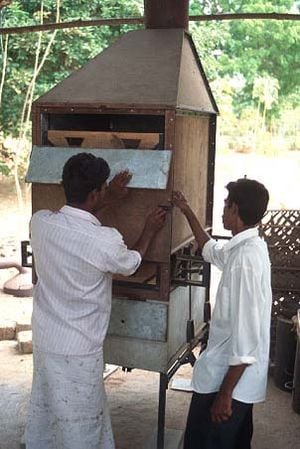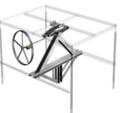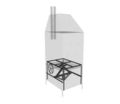The Cashew nutis one of the most popular edible seeds in the world and can be enjoyed in many forms (raw, roasted, cooked etc.) Sri Lanka is home to some of the best varieties of cashew and cashew related activities are widespread. Cashew does not grow everywhere, but its processing activities can be done at any location. The initial processing (drying, decorticating- or removing outer shell, removing testa - inner shell) is a done mainly by rural women. In order to make the removal of the outer shell more efficient, it is necessary to dry or oven the cashew nuts. In a traditional system, the “hot cupboards” or the ovens belong to the middlemen or the “mudalalis”. They sell the raw cashew to the women who decorticate them and bring them to the mudalali for ovening.
The hot cupboards need electricity, and a substantial quantity of cashew for ovening. The placement of the electric coil causes uneven heating which leads to irregular drying which causes some wastage in the drying process. These features make it uneconomical to micro scale cashew processors1. A group of women who were involved in cashew processing requested Practical Action South Asia to develop a dryer that was suited for their purposes. The dryer was developed along with the inputs from these users.
The Anagi Dryer[edit | edit source]
This dryer comprises a drying chamber that includes six trays, a furnace, a heat exchange system and a lifting mechanism for the trays.
The drying chamber is made out of chipboard or timber planks (externally) lined with aluminium sheets both internally and externally. This arrangement reduces the heat loss and ensures that there is an even temperature inside the chamber.
It has a dome-shaped roof enhances the out flow of moist air.
A removable dial thermometer is connected to the drying chamber.
There are 6 trays in the dryer.
The flue gas from the stove passes through a heat exchanger. The incoming air from the bottom of the dryer gets heated and moves upwards through the trays in the drying chamber. The dryer has been fitted with a lifting mechanism with which the trays can be easily loaded, unloaded and moved downwards. A simple mechanical jack system operated by a lever, controls the lifting and lowering of the trays. The cashew in the lowest trays dries faster than in the top trays.
The dryer can also be fitted with adjustable “flappers” on the top and bottom, to control the heat flow.
Advantages of the Anagi Dryer[edit | edit source]
- The Anagi dryer uses paddy husk or saw dust as an energy source and is freely available in rural areas and can also be used in palces that do not have access to electricity.
- The uneven drying of cashew has been overcome because the heat flow can be controlled
- The dryer, which has a simple lifting mechanism, permits the removal of a tray and the loading of a new tray with fresh produce while the dryer is operational. This allows for higher output, higher quality, prevents over roasting and improved fuel efficiency.
- It is low cost, easy to operate and maintain and can be assembled in small workshops.
- Can be easily operated by women.
Technical Details[edit | edit source]
Construction[edit | edit source]
- The frame of the dryer is fabricated with 1 1/4"X1 1/4"X1/8" and 1"X1"X1/8" angle iron.
- The main body of the dryer is fabricated with 1" thick albesia timber planks or chip board lined both sides with gauge 21 aluminium sheets.
- The heat exchanger tubes are 125 mm in diameter and are fabricated from gauge 16 GI sheets
- A 425 mm diameter barrel is used for the hearth. The stove lid is made out of gauge 16 GI sheets.
- Tray frames are fabricated out of light duty pipes with a diameter of 20mm.These pipe are affixed to planks made out of 1-inch thick timber (Albesia). An aluminium wire mesh is used for the base of the tray.
- A screw type jack fitted to a hand wheel is used as the lifting mechanism.
NOTE: See diagrams for details.
Operation[edit | edit source]
- The furnace is filled with sawdust (about 30 Kg.). It is well compacted leaving a cylindrical opening at the centre (vertical) extending it horizontally at the bottom. This is done by inserting two GI pipes of 75mm diameter before packing with sawdust. Once the packing is complete the two GI pipes are pulled out carefully creating two tunnel-shaped openings.
- The furnace is ignited by a piece of coconut husk or a piece of wood dipped in kerosene oil, inserted through the bottom opening.
- Before firing, the lid of the furnace is closed and connected to the heat exchanger pipes. The furnace can supply heat to the dryer for about 6-8 hrs.
- There are 6 trays in the dryer. Once the trays are in position, the door of the dryer is closed.
- 2 ½ - 3 hours after the initial loading the bottom-most tray is removed and a new one is loaded at the top. After which this procedure is repeated every half and hour.
- The temperature must be kept below 800C for cashew. Adjusting the ventilation of the hearth can control the temperature.
- Excessive heating inside the drier can be eliminated by controlling the airflow by using the flappers located above the heat exchanger coils. These flappers can be used to maintain a constant heat supply throughout the tray.
- The door of the dryer, has two flaps; one flap at the top to insert trays and another at the bottom to remove the trays.
- The lifting mechanism allows the removal of the lowermost tray when the cashew is dry. After the tray has been removed, the rest of the trays can be lowered and a new tray can be added at the top.

Maintenance[edit | edit source]
- The dryer needs to be cleaned daily
- The heat exchanger pipes need to be cleaned daily to avoid corrosion.
- The pipes and tubes need to be checked and replaced in 6 - 12 months.
Cost[edit | edit source]
At present (2000) local fabrication costs is estimated between Rs 26,000 – Rs 28,000 (US$ 380)
Manufacturers[edit | edit source]
H.P. Thillekeratne
Galahenawatte
Dematagolla
Minuwangoda
Sri Lanka.
Nihal Ashoka
Ashoka Industries
Kirama Walgammulla
Sri Lanka
T.P. 071-764725T.
T.D. Norman
Contact Engineers
Negombo Road
Malkaduwawa
Kurunegala
Sri Lanka
Eastern Technical Institute
Bar Road,
Batticaloa
Sri Lanka
T.P. 065- 22790
References and further reading[edit | edit source]
- Cashew Nut Processing, Practical Action Technical Brief: Cashew nut processing (Practical Action Brief)
- Drying of Food, Practical Action Technical Brief Drying of foods (Practical Action Brief)
- Drying * Technologies, Practical Action Technical Brief
- Solar Drying, Practical Action Technical Brief
- Tray Dryers, Practical Action Technical Brief
- Drying Food for Profit: A Guide for Small Businesses, Barrie Axtell, ITDG Publishing, 2002 Drying Foodstuffs: Techniques, Processes, *Equipment, Jean-Franςois Rozis, Backhuys Publishers, 1997
- Producing Solar Dried Fruit and Vegetables for Micro-and Small-scale Rural Enterprise Development: A Series of Practical guides, Natural Resource Institute, 1996
For further information on the Anagi Tray Dryer contact: Practical Action South Asia 5 Lionel Edirisinghe Mawatha Kirulapone Colombo 5 Sri Lanka Tel: +94 11 2829412 Fax: +94 11 2856188 Email: srilanka@practicalaction.org.lk






